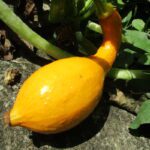round fruit
Most suburban dwellers don’t have the space and the sun exposure required to grow pumpkins, the big round fruit has a sprawling growth habit and an unruly disposition that doesn’t endear it to its tamer vegetable companions.
If you still want to grow pumpkins, here is how: pumpkins appreciate humus rich soils that hold water well but don’t get soggy, a good amount of organic fertilizer, warmth and plenty of sunshine.
Sow the seeds in spring, after all danger of frost has passed, in hills of four or five seeds, just like you do for summer squash or cucumbers. Space the nests at least three feet in each direction, and four to six feet for the trailing varieties. After the seedlings emerge, thin them to two or three, without disturbing the roots. If you grow the trailing pumpkins on netting you will need to make hammocks to support the heavy fruit.
Pumpkins need a long hot summer to mature, they take about five months from seed to harvest. When the fruit begins to sound hollow and the stem turns hard and starts to crack it’s harvest time.
If you want to store pumpkins they need to be ‘cured’, which is achieved by leaving them in a sunny and dry location for ten days or so until their skin hardens.
According to farmers who have grown every conceivable pumpkin there is, the best variety for pie is Cinderella, whose flat, deep orange fruit is shaped like a Turkish pillow. Its flavor is strong and sweet and it is a very old variety, cultivated since the time of the settlers. It is believed to have been served at the early Pilgrims’ Thanksgiving table.




 Previous Post
Previous Post Next Post
Next Post




